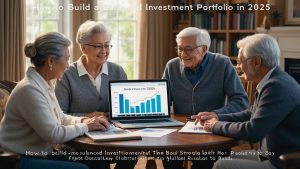The Foundation of Successful Wealth Building
Creating a robust investment portfolio requires more than just picking a few hot assets and hoping for the best. As we approach 2025, the financial landscape presents both unique challenges and opportunities that demand a more thoughtful approach. The key lies in understanding how different asset classes interact with each other and how they fit into your personal financial picture. Many investors make the mistake of chasing last year’s winners or trying to time the market, strategies that often lead to disappointment when market conditions shift unexpectedly.
A truly balanced portfolio acts like a well-tuned engine, with each component serving a specific purpose while working in harmony with the others. Stocks provide growth potential, bonds offer stability, and alternative assets can provide diversification benefits. The exact mix should reflect your individual goals, time horizon, and comfort with volatility. What works for a recent college graduate won’t necessarily suit someone approaching retirement, which is why cookie-cutter portfolio solutions often fall short of expectations.
Crafting Your Diversified Retirement Strategy
When building a diversified retirement portfolio, the conventional wisdom about shifting to bonds as you age may need reconsideration in today’s longer retirement periods. With people regularly living 20-30 years beyond their retirement date, maintaining some growth potential in your portfolio becomes crucial to combat inflation’s erosive effects. This doesn’t mean taking unnecessary risks, but rather finding the right balance between preservation and growth that can sustain your lifestyle for decades.
Target-date funds have gained popularity for retirement accounts, but they often take a one-size-fits-all approach that might not match your specific needs. A more customized solution might involve creating separate buckets for different time horizons – keeping money needed within five years in more stable investments while allowing longer-term funds to remain in growth-oriented assets. Regular rebalancing ensures your portfolio doesn’t drift too far from its intended risk level, especially important as you transition from wealth accumulation to distribution phases.

Selecting Quality Investments for Growth
Identifying the best stocks to buy involves more than just looking at past performance or popular trends. Fundamental analysis remains crucial, examining factors like strong balance sheets, competitive advantages, and capable management teams. Growth potential matters, but so does valuation – even excellent companies can become poor investments if purchased at inflated prices. Many successful investors focus on businesses they understand, with sustainable models that can thrive across economic cycles.
Sector diversification prevents overexposure to any single industry’s fortunes. While technology stocks might dominate headlines, a healthy portfolio includes companies from various sectors that respond differently to economic conditions. Consumer staples and healthcare often prove more resilient during downturns, while cyclicals like industrials and materials tend to lead during recoveries. The exact allocation depends on your outlook and risk tolerance, but avoiding concentration in any single area helps manage overall portfolio volatility.
Navigating the Mutual Fund Versus Stock Decision
The mutual funds vs stocks debate isn’t about choosing one over the other entirely, but rather determining the right mix for your situation. Mutual funds (and their ETF cousins) offer instant diversification and professional management, particularly valuable for investors without the time or expertise to research individual companies. Index funds take this a step further with lower costs by simply tracking market benchmarks rather than trying to outperform them.
Individual stocks allow for more targeted bets and can be more tax-efficient since you control when to realize gains. However, they require substantial research and monitoring to avoid concentration risk. Many investors find a hybrid approach works best – using funds for core positions while allocating a smaller portion to individual stock picks. This provides broad market exposure while still allowing for selective opportunities where you might have particular insight or conviction.
Implementing Comprehensive Financial Planning
Effective financial planning strategies extend far beyond just picking investments. Tax considerations, estate planning, insurance needs, and cash flow management all play crucial roles in your overall financial health. A well-structured investment portfolio forms just one piece of this larger puzzle. Smart investors coordinate their investment decisions with other aspects of their financial life, such as maximizing tax-advantaged accounts or structuring withdrawals in retirement to minimize tax burdens.
Regular portfolio reviews should assess whether your investments still align with your evolving goals and circumstances. Major life events like marriage, children, career changes, or inheritance often warrant portfolio adjustments. Working with qualified professionals can help identify blind spots in your plan, though ultimately you should understand and agree with every strategy implemented in your portfolio. The best financial plans grow and adapt with you over time rather than remaining static documents.
Adapting to 2025’s Investment Landscape
Looking ahead to 2025, several trends could influence portfolio construction. Higher interest rates have made fixed income investments more attractive after years of meager returns. Geopolitical uncertainties continue highlighting the value of diversification across regions and asset classes. Technological advancements create new opportunities while disrupting traditional business models, requiring investors to stay informed without overreacting to every development.
The principles of sound investing haven’t changed – spend less than you earn, invest the difference wisely, and maintain a long-term perspective. However, the tools and opportunities available to implement these principles continue evolving. Staying educated while avoiding reactionary decisions positions investors to navigate whatever 2025 brings. Your portfolio should reflect both timeless wisdom and thoughtful adaptation to current realities, creating a financial foundation that can support your goals through various market environments.
